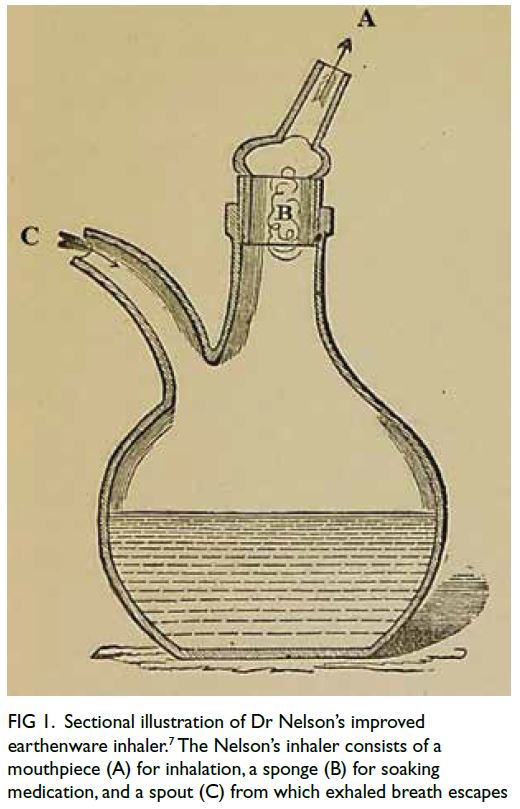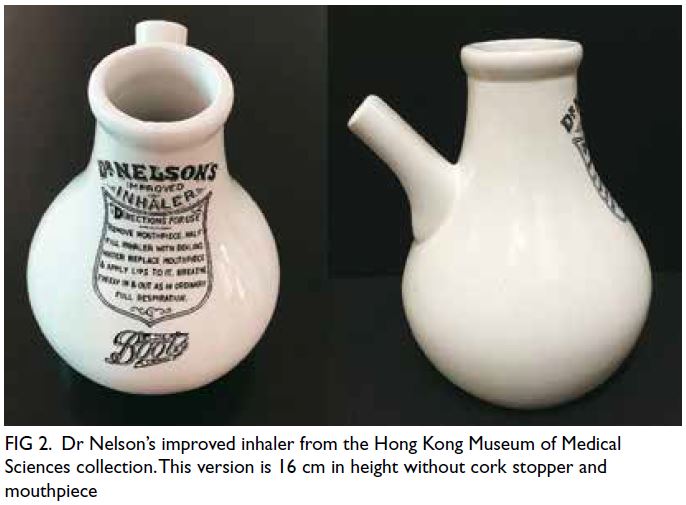© Hong Kong Academy of Medicine. CC BY-NC-ND 4.0
REMINISCENCE: ARTEFACTS FROM THE HONG KONG MUSEUM OF MEDICAL SCIENCES
The Nelson’s inhaler
Rose HL Mak, FHKAM (Paediatrics)
Director, Hong Kong Museum of Medical Sciences Society
The Nelson’s inhaler is an earthenware vessel
that enables inhalation of the vapour of water and
medicinal substances (Fig 1). It was introduced on
28 May 1861 when Dr Nelson presented his recent
invention to the fellows of the Royal Medical and
Chirurgical Society of London at the conclusion
of a meeting. He drew their attention particularly
to its ‘great ease and simplicity of action, perfect
cleanliness, and an arrangement of the mouth-piece
by which is secured economy in the use of
any medicated ingredient that may be required for
inhalation’.1

Figure 1. Sectional illustration of Dr Nelson’s improved earthenware inhaler.7 The Nelson’s inhaler consists of a mouthpiece (A) for inhalation, a sponge (B) for soaking medication, and a spout (C) from which exhaled breath escapes
Respiratory ailments were rampant in Britain
at that time due to industrialisation and rapid
urban development that had occurred before the
sanitary revolution. Physicians who treated these
conditions were aware of the advantages that
inhaling medications directly into the lungs would
bring, but there was no suitable apparatus available. The demonstration of ether as an inhalational
anaesthetic in 1846 and, later, the successful use of
antiseptic heightened interest in the inhalational
administration of medication. Dr Nelson was
one of those who had spent time inventing and
experimenting with inhalation devices.
Dr John Mudge invented the first inhaler in
1778 and even coined the term. The purpose of his
invention was to provide a ‘radical and expeditious
cure for a recent catarrhous cough’ using hot water
and added herbs or medicinal products (such as
opium).2 The inhaler became popular and was used
both in hospitals and by patients at home, but those
with respiratory ailments struggled to inhale against
the pressure of the water.3 In 1865, S Maw & Son,
a prominent medical equipment manufacturer,
launched the Dr Nelson’s improved earthenware
inhaler with a notice in The Lancet. It was promoted as
a ‘very handy, cheap, simple and effective apparatus’.4
The promotional notice included the following
instructions for use: “Remove the corked stopper,
and fill the vessel half full of hot water; then pour the
remedy to be employed upon the sponge contained in
the hollow tube at B; and, having replaced the latter,
inhale the vapour through the mouth-piece at A, the
exhaled breath passing freely through the tube at C.
For the inhalation of the vapour of hot water only, or
the infusion of stramonium, hops, or other medicinal
plants, the sponge in the tube need not be displaced.”4
The new inhaler was well received by the
medical profession. In 1867, five vapour medications
(eg, vapor creasoti and vapor iodi) were incorporated
into the British Pharmacopoeia for the first time.5
In 1870, the inhaler was advertised in the British
Medical Journal as ‘a most efficient apparatus for the
inhalation of the vapour of hot water, either alone
or impregnated with ether, chloroform, henbane,
creosote, vinegar, etc., in affections of the throat and
bronchial tubes, asthma, consumption, etc.’6
The new inhaler was also well received by
patients and self-medicators. Its ‘great ease and
simplicity of action’ minimised errors when using
the device. Being earthenware, it was not liable to
corrosion and could be easily cleaned; it was also
readily available and affordable. From among the
numerous inhalers available at that time, Nelson’s was
selected to illustrate the use of an inhaler in Spencer
Thomson’s A Dictionary of Domestic Medicine and
Household Surgery.7 Over time, many different
designs of Nelson-type earthenware inhalers were produced, as witnessed by the variety collected in
many museums. The item in the collection of the
Hong Kong Museum of Medical Sciences bears the
logo of ‘Boots the Chemists’ and could have been
produced before the logo changed in the 1960s (Fig 2).

Figure 2. Dr Nelson’s improved inhaler from the Hong Kong Museum of Medical Sciences collection. This version is 16 cm in height without cork stopper and mouthpiece
From the mid-1900s, steam inhalers were
gradually replaced by safer and more effective drugs
(such as antibiotics, bronchodilators, steroids, and
mucolytics) and delivery systems (such as metered-dose
inhalers, dry-powder inhalers, soft mist
inhalers, and nebulisers). In Hong Kong, the Nelson’s
inhaler was used in hospitals until the 1980s (J Lui,
Senior Nursing Officer at Queen Mary Hospital from 1995 to 2007, oral communication, November
2021). Before then, tincture benzoin compound was
usually prescribed for inhalation as an expectorant.
The prepared pot would be wrapped in towels and
patients would sit in bed and inhale the vapours for 10
to 15 minutes (J Lui, oral communication, November
2021). The Nelson’s inhaler is still produced today
and is mainly used by singers to soothe their vocal
cords.
When the various inhalers were first invented,
their performance was not evaluated. While the
Nelson’s inhaler was popular, it was not specifically
referred to in case reports. Although many
advocated the use of inhaled vapours, the practice
also had its detractors.8 Williams9 concluded in
1888 that medicinal inhalations were more useful
for conditions of the pharynx, larynx and larger
bronchi but that their effects on lung parenchyma
were doubtful. He questioned whether the methods
available at the time could deliver medications
to the lungs as effectively as the oral route of
administration.9
More recently, in 2017, Murnane et al10
conducted modern inhalation performance testing
of the Nelson’s inhaler using simulated adult
breathing and a preparation of benzoic acid. They
demonstrated that about 45% of the benzoic acid
emitted from the inhaler had an aerosol size of
<6.4 μm and therefore could reach the lungs.10 This
finding could partly explain the inhaler’s enduring
popularity.
Invented 160 years ago, the Nelson’s inhaler
will be remembered as a ‘simple and effective’
apparatus that helped to establish inhalation as a
popular treatment for respiratory ailments.
References
1. Proceedings of the Royal Medical and Chirurgical Society of London, Volume III, Sessions 1860-61. May 28, 1861. Available from: https://books.google.ne/books?id=3fJXAAAAMAAJ&pg=PA421&hl=fr&source=gbs_selected_pages&cad=2#v=onepage&q&f=false. Accessed 26 Aug 2023.
2. Cohen JS. Inhalation in the Treatment of Disease: Its Therapeutics and Practice. A Treatise on the Inhalation of Gases, Vapors, Fumes, Compressed and Rarefied Air, Nebulized Fluids, and Powders. Philadelphia: Lindsay & Blakiston; 1876. Part I, Chapter on Inhalers, pages 19-20. Available from: https://archive.org/details/63720410R.nlm.nih.gov/mode/1up?view=theater. Accessed 26 Aug 2023.
3. Slatter EM. The evolution of anaesthesia. 2. The first English ether inhalers. Br J Anaesth 1960;32:35-45. Crossref
4. New inventions in aid of the practice of medicine and surgery. Dr. Nelson’s improved earthenware inhaler. The Lancet General Advertiser 1865;85:152.
5. General Council of Medical Education and Registration of the United Kingdom. British Pharmacopoeia, 1867. London: Spottiswoode; 1880. Available from: https://wellcomecollection.org/works/pw22vz6d/items?canvas=27&query=100. Accessed 26 Aug 2023.
6. Dr Nelson’s Improved Earthenware Inhaler (advertisement). Br Med J 1870;2:(520):Back Matter.
7. Thomson S. A Dictionary of Domestic Medicine and Household Surgery. 32nd ed. London: Charles Griffin & Company Limited; 1897: 354. Available from: https://wellcomecollection.org/works/etx3jv42/items?canvas=373&query=inhaler. Accessed 26 Aug 2023.
8. Hassall AH. On inhalation, more particularly antiseptic inhalation, in diseases of the lungs. Br Med J 1883;2:869-71.
9. Williams CT. The value of inhalations in the treatment of lung disease. Br Med J 1888;2:700-3. Crossref
10. Murnane B, Gallagher CT, Snell N, Sanders M, Moshksar R, Murnane D. Dispersing the mists: an experimental history of medicine study into the quality of volatile inhalations. J Aerosol Med Pulm Drug Deliv 2017;30:157-63. Crossref

